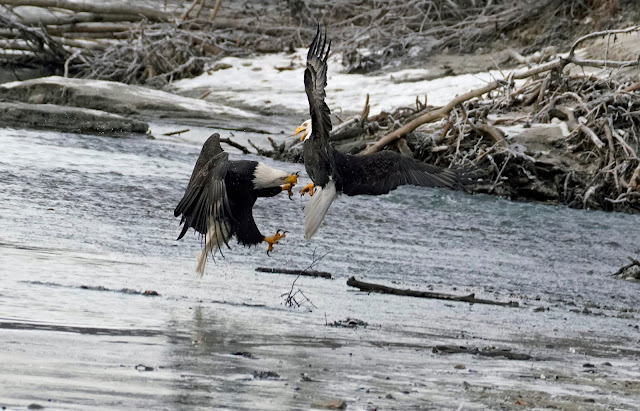Dale Matson
Click Photographs To Enlarge
Dale With Monopod
One of my favorite wildlife
photography subjects is the eagle. I must say that much of my local winter
wildlife experience is at Millerton Lake. There are many more eagles in the
winter who have migrated to Millerton to avoid the harsh winters at Great Slave
Lake in Canada. At Millerton Lake, knowing where the eagles congregate has been
useful along with where their main food source, the coots, are available. Much
of eagle photography for me has been learned by the photos…what works and what
does not work. There are also camera and lens limitations and not having the
right tool for the job is frustrating.
As someone who was primarily a
landscape photographer, I found eagles to be much more challenging. Some things
carry over like composing a shot but with eagles, decisions are time limited. I
have learned to look for the drama and how a shot tells a story. I have learned
to read the body language of eagles and generally know when they are about to
fly.
All of this said, if you ever go to
Haines AK when the Salmon are spawning, you will have an entirely new
experience. There are roughly 4,000 eagles gathered along a short stretch of
the Chilkot River. Generally, I had already learned that a perched eagle was
less interesting than a flying eagle (BIF). In the morning when the eagles are
more active, the light is low and a fast shutter speed makes for a high ISO
photograph for most of the lenses in the 100-400mm range which are more
affordable than a 400mm F 2.8 prime lens.
Being in a group of four
experienced photographers led by a guide who is also a photographer helped me
to learn so many things I was previously not aware of. I generally used the
“spray and pray” method. The best photographers took less photographs and were
careful to compose a shot first.
It was a rare occasion when birds
in trees did not have intervening branches and the photographers avoided most
of those shots even when the bird was close (less than 20’ away) They wanted
the whole bird and they wanted to fill the frame without any part of the bird
being out of the frame.
You could tell by the sound of the
Nikons and Canons all fired at the same time that the money shot was always
when an eagle was eating a salmon and other eagle would occasionally converge
on that eagle. My Sony had silent shutter. In those cases, less magnification
was better to keep the birds in the frame and taking my teleconverter off meant
I also had additional light and could increase my speed to 1/1600. The birds in
flight were more likely to be 1/2000. 1/650 was fine for a bird on the ground.
I was able to get close enough to birds on the ground (10’) that the eagle to
fill the frame.
Shutter speed can be limited by
light but also by the speed of the SD card, Jpeg or Raw, using both cards
simultaneously, frame rate and buffer size crop or full frame.
I shouldn’t have been surprised but
overcast skies were better conditions for even light than sunny skies. This is
not the same as ideal landscape ideal conditions.
I’m sure that most of the
photographers in the several groups believe that their big lenses held up by
big tripods with gimbals was the way to go. But most of the shots were close to
very close. I had the Sony A7R3 with the 100-400mm GM lens. I used a monopod
for longer shots with the 400 and 1.4 TC for birds on the ground. All the rest
of my shots were hand held as I sat on a folding stool with my elbows resting
on my knees. At age 74 It was much more comfortable than standing behind a
tripod. When other photo opportunities came up, my gear was also the most
portable.
Did I get the best photographs? No,
but I leaned lots beginning with ordering a Sony A9 which is a better action
camera than the high resolution A7R3.
The Following Photos Were Taken By Sharon
Our Group [Back] Guide Carl Tom Sharon [Front] Dale Sharon My Wife







































I emailed our guide Carl about my blaze orange winter jacket prior to our trip. His response was, "No worries". Eagles do have color vision but don't seem to mind blaze orange more than any other color. Some of my fellow photographers were less accepting. My experience photographing eagles near home has been that eagles have such keen vision that they know you are there even when you and your camera are in full camouflage.
ReplyDeleteTripod or no, your shots are awesome. I love the one where the eagle is looking straight toward you, close up.
ReplyDeleteI like the orange coat, too!
ReplyDeleteAnybody who thinks they can sneak up on an eagle wearing camouflage is only kidding himself. Eagles see you long before you see them.
ReplyDelete